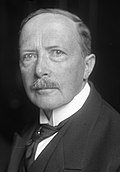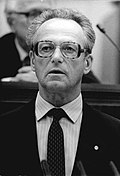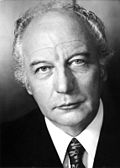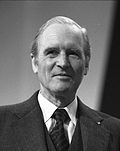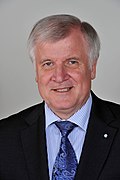| Portrait | Bundespräsident | Took office | Left office | Time in office | Party | Election |
|---|
| Arnold, Karl Karl Arnold
(1901–1958)
Acting
[e] | 7 September 1949 | 12 September 1949 | 5 days | | CDU | – |
| Heuss, Theodor Theodor Heuss
(1884–1963) | 12 September 1949 | 12 September 1959 | 10 years | | FDP | 1949
1954 |
| Lübke, Heinrich Heinrich Lübke
(1894–1972) | 13 September 1959 | 30 June 1969
(resigned) | 9 years, 290 days | | CDU | 1959
1964 |
| Heinemann, Gustav Gustav Heinemann
(1899–1976) | 1 July 1969 | 30 June 1974 | 4 years, 364 days | | SPD | 1969 |
| Scheel, Walter Walter Scheel
(1919–2016) | 1 July 1974 | 30 June 1979 | 4 years, 364 days | | FDP | 1974 |
| Carstens, Karl Karl Carstens
(1914–1992) | 1 July 1979 | 30 June 1984 | 4 years, 365 days | | CDU | 1979 |
| Weizsäcker, Richard Richard von Weizsäcker
(1920–2015) | 1 July 1984 | 30 June 1994 | 9 years, 364 days | | CDU | 1984
1989 |
| Herzog, Roman Roman Herzog
(1934–2017) | 1 July 1994 | 30 June 1999 | 4 years, 364 days | | CDU | 1994 |
| Rau, Johannes Johannes Rau
(1931–2006) | 1 July 1999 | 30 June 2004 | 4 years, 365 days | | SPD | 1999 |
| Köhler, Horst Horst Köhler
(1943–2025) | 1 July 2004 | 31 May 2010
(resigned) | 5 years, 334 days | | CDU | 2004
2009 |
| Böhrnsen, Jens Jens Böhrnsen
(born 1949)
Acting
[e] | 31 May 2010 | 30 June 2010 | 30 days | | SPD | – |
| Wulff, Christian Christian Wulff
(born 1959) | 30 June 2010 | 17 February 2012
(resigned) | 1 year, 232 days | | CDU | 2010 |
| Seehofer, Horst Horst Seehofer
(born 1949)
Acting
[e] | 17 February 2012 | 18 March 2012 | 30 days | | CSU | – |
| Gauck, Joachim Joachim Gauck
(born 1940) | 18 March 2012 | 18 March 2017 | 5 years | | Independent | 2012 |
| Steinmeier, Frank-Walter Frank-Walter Steinmeier
(born 1956) | 19 March 2017 | Incumbent | 8 years, 298 days | | SPD | 2017
2022 |


